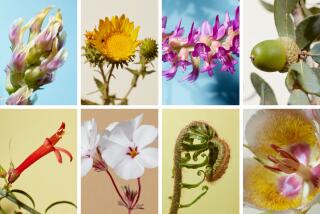John Muir’s botanical pursuits brought to life
- Share via
John Muir loved plants. He loved their individual microscopic parts. He loved each one’s totality. He understood their essential role in the vast, interconnected web that forms the fabric of our natural universe. Extinguish even the most seemingly minor plant, he wrote, and the fabric starts to unravel.
Muir (1838-1914) is best known as an environmental activist, a founder of the Sierra Club and arguably America’s earliest and most effective conservationist. It was Muir who helped persuade an industrializing nation that it should preserve its wilderness, not desecrate it. Without Muir’s activism, America would not have Yosemite or other national parks.
In Heyday Books’ recently released “Nature’s Beloved Son: Rediscovering John Muir’s Botanical Legacy,” however, author Bonnie J. Gisel and photographer Stephen J. Joseph focus on the man’s more private passion: botany.
Muir spent much of his life on epic solitary walks to study plants in the wilderness. He crossed the U.S., Canada, Alaska, South America and Africa, always carrying a plant press with him. He used it to dry and preserve the specimens he mailed to friends and family, along with copious (and sometimes overwrought) notes on where and how he found them.
He was a faith-based botanist who believed that only a higher power could have designed nature’s magnificence and all the built-in mechanisms for its perpetuation.
Of the angiosperms, flowering plants with encased seeds that can be dispersed by the wind, Muir wrote: “Plans of another year, of thousands of years wrapped up in them. . . . Wet with dew or rain, sun shining through them, they shoot glad and blithesome into the welcoming sky in immortal health.”
Wading through a remote and icy Ontario swamp, he came upon a single white flower blooming on a bed of moss. The beauty of this lone Calypso borealis orchid, he wrote, was “pure enough for the throne of its creator.”
Gisel and Joseph spent four years traveling the nation to find the specimens Muir had mailed, now more than 100 years old and often in tatters. They were located in universities, private collections and in the attics of Muir’s descendants.
Joseph, a nature photographer based in the Bay Area, used digital enhancement techniques to re-create each as it must have looked when Muir first preserved it. The result is botanical art, 150 stunning images of dried plants, each suitable for framing.
Gisel, an environmental historian and Muir scholar, captures the science and spirituality of her subject’s legacy. In a world attempting to go green, this backward glance points the way forward.
Gisel summed it up in an interview about the book: “We forget that all life forms on Earth are totally dependent on plants and their pollinators for both food and oxygen. Without plants, we will not be here. It is nature that sustains us. Muir understood that. And so must we.”
More to Read
Sign up for The Wild
We’ll help you find the best places to hike, bike and run, as well as the perfect silent spots for meditation and yoga.
You may occasionally receive promotional content from the Los Angeles Times.










